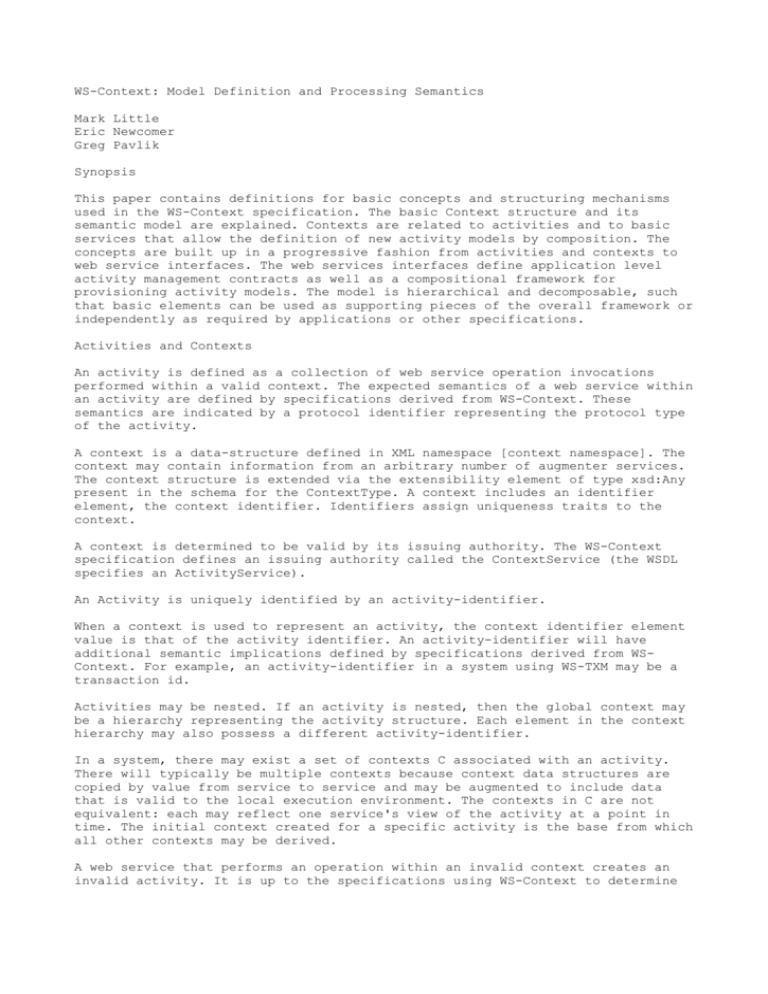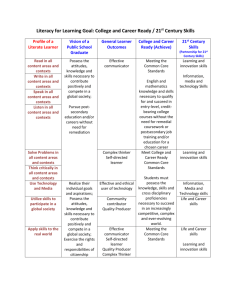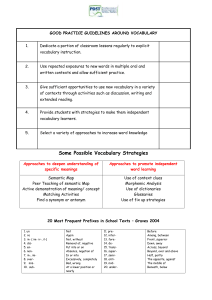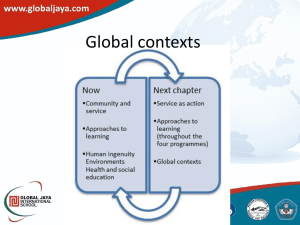Activities and Contexts
advertisement

WS-Context: Model Definition and Processing Semantics Mark Little Eric Newcomer Greg Pavlik Synopsis This paper contains definitions for basic concepts and structuring mechanisms used in the WS-Context specification. The basic Context structure and its semantic model are explained. Contexts are related to activities and to basic services that allow the definition of new activity models by composition. The concepts are built up in a progressive fashion from activities and contexts to web service interfaces. The web services interfaces define application level activity management contracts as well as a compositional framework for provisioning activity models. The model is hierarchical and decomposable, such that basic elements can be used as supporting pieces of the overall framework or independently as required by applications or other specifications. Activities and Contexts An activity is defined as a collection of web service operation invocations performed within a valid context. The expected semantics of a web service within an activity are defined by specifications derived from WS-Context. These semantics are indicated by a protocol identifier representing the protocol type of the activity. A context is a data-structure defined in XML namespace [context namespace]. The context may contain information from an arbitrary number of augmenter services. The context structure is extended via the extensibility element of type xsd:Any present in the schema for the ContextType. A context includes an identifier element, the context identifier. Identifiers assign uniqueness traits to the context. A context is determined to be valid by its issuing authority. The WS-Context specification defines an issuing authority called the ContextService (the WSDL specifies an ActivityService). An Activity is uniquely identified by an activity-identifier. When a context is used to represent an activity, the context identifier element value is that of the activity identifier. An activity-identifier will have additional semantic implications defined by specifications derived from WSContext. For example, an activity-identifier in a system using WS-TXM may be a transaction id. Activities may be nested. If an activity is nested, then the global context may be a hierarchy representing the activity structure. Each element in the context hierarchy may also possess a different activity-identifier. In a system, there may exist a set of contexts C associated with an activity. There will typically be multiple contexts because context data structures are copied by value from service to service and may be augmented to include data that is valid to the local execution environment. The contexts in C are not equivalent: each may reflect one service's view of the activity at a point in time. The initial context created for a specific activity is the base from which all other contexts may be derived. A web service that performs an operation within an invalid context creates an invalid activity. It is up to the specifications using WS-Context to determine the implications of invalid activities (which may be insignificant or severe) and provide structuring mechanisms that avoid invalid activities if necessary. From the above, we may observe that a context is associated with one and only one activity; "compound" contexts do not exist. The set of operations represented by A may be used to define more than one activity; for example, the operations in A may include a context for a security protocol and a context for a transaction protocol, each representing a separate activity. Typically, there is a partial intersection for overlapping activities in a system: the normal mechanism for creating an activity is via the Begin operation on the ContextService PortType. If Begin is used to initiate the creation of the first operation of an activity a, the first use of Begin in a system will normally not be contextualized. The Begin operation is not part of an activity and the subsequent Begun message will be the first operation in a, but no other activity. Contexts may be passed by reference or by value within a system. Contexts that are passed by value are considered to be snapshot copies of the context at the point in time at which the context was created or augmented. Contexts that are passed by reference may always be de-referenced to retrieve the equivalent “by value” copy of the context. Dereferencing may be performed by familiar protocol URL handlers and/or by reference to a ContextManager web service identified by a web service reference contained in the context. Implementations or deployments may prefer to use a particular approach for reasons of efficiency (eg, byreference contexts that contain particularly large data blocks, by-reference copies of sensitive data with access control for dereferencing, or by-value copies of contexts with smaller blocks of protocol processing elements). ContextService and ActivityLifecycleService WS-Context provides a mechanism for creating activities: the ContextService PortType. A ContextService may be used to create activities of more than one protocol type. Each protocol type is identified by a protocol identifier. The protocol type (referred to as type in the current context schema) is included in the Begin message when the Begin operation is invoked on the ContextService. A ContextService may be used to create activities for a protocol in association with an ActivityLifecycleService. There are two distinct "interfaces" to the context service - the one that a user of a context sees (essentially Begin), which returns a context that can then be sent on requests to services, and the one that ALS-es use to register with the context service. The intention is that the former be mandated, whereas the latter is optional. So, WS-Context mandates how you get a context (that may be transactional, secure, replication enhanced, ...) but not how that context was created. However, for those application and service developers who wanted to standardise on context creation, there is the optional ALS. At present the WSContext specification doesn't make that distinction between optional and mandatory clear enough, though WS-CF does refer to it. It follows that applications are aware of protocol types (transactional activity, secure activity, etc.), but the ALS configuration (e.g., how an activity is made transactional) is opaque to users of the Context Service. The handshake between the ContextService and the ActivityLifecycleService is straightforward. When a Begin message is sent to the ContextService, an implementation may contact each registered ALS in order to send back a context element for the ultimate SOAP header block. An ALS will augment the context element by inserting protocol specific markup into the element(s) of type xsd:Any defined in the context schema. Once all ALS-es registered for a specific protocol have been contacted, the complete context is returned to the UserContextService PortType implementation as a header on the Begun message (the protocol type is embedded within the context). Contexts are passed by value between the ContextService and ALS. How ALSs map to the protocol-type is outside the scope of the specification. In addition, the number of ALSs that are required to fulfil a particular protocoltype is also not mandated. How ALSs collaborate with each other is out of scope for WS-Context. ALS services may use out of band techniques to fulfil any special requirement required to create well-formed contexts for “compound” protocols. For example, an activity that is both secure and transactional may be implemented as a single ALS or as two ALSs, and yet both may fulfil the requirement for the same protocol-type. When a context for a protocol supported by a ContextService is present on the invocation of a Begin operation on the ContextService, a nested activity is created. The new activity is a child of the activity identified by the context associated with the operation invocation. The ALSs will augment the new context, which is returned to the UserContextService (currently, UserActivityService) with the Begun message. Derived specifications for specific protocols may define the characteristics of the nesting relationship further, including faulting semantics between parents, children and siblings, or may disallow nesting altogether. The nesting relationship is communicated from the ContextService to a registered ALS(s) in the context header. An ALS will consider a context header that contains a reference to a parent context to be modelled as a nested activity. The reason for passing the hierarchy information for an activity is that generally protocols may be able to use this to either perform optimisations or to determine parent-child relationships critical to the execution of the protocol. For example, in the area of security there are protocols that define parent and child security domains, and enable parent access control lists (ACLs) to be inherited by children. Obviously nested scopes may be started on one node and the actual work that is to be performed securely on another node. Therefore the parent-child relationship needs to be communicated between nodes and this is done through context. Likewise with distributed (nested) transactions. If the entire hierarchy is passed between nodes (both on the “downward” journey and on the “upward” response”), optimisations to the protocol can occur. For example, low-cost interposition, where a new nested transaction hierarchy is created at a receiving domain and returned to the sending domain, where the corresponding interposition hierarchy is set up. With epidemic replication protocols, where state updates occur whenever any communication occurs between replicas (including periodic heart-beats and gossips), the state data (typically deltas) accompany these messages (even if, as is more usual in these situations, the messages are application invocations on services). Many epidemic protocols are also weak consistency protocols, where replica states may diverge and replicas may even present different states to different clients, often in a structured (nested) consistency-domain fashion (for instance, a parent context may contain state that is out of date by 1 minute, while a child state is out of date by 1 hour etc. but the different deltas for each consistency domain are propagated.)







